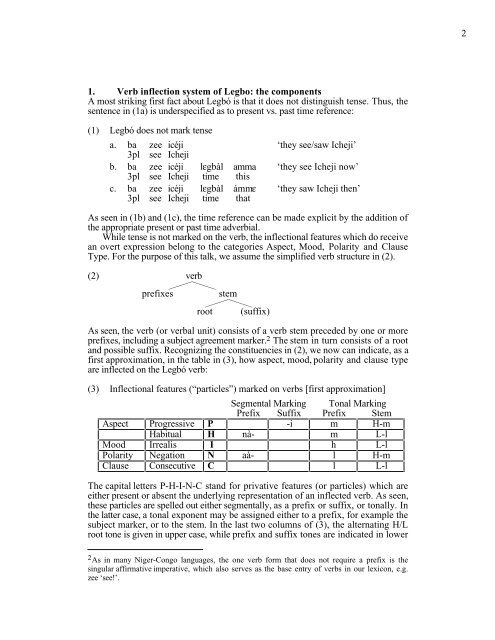Legbo Verb Inflection: A Semantic and Phonological ... - Linguistics
Legbo Verb Inflection: A Semantic and Phonological ... - Linguistics
Legbo Verb Inflection: A Semantic and Phonological ... - Linguistics
You also want an ePaper? Increase the reach of your titles
YUMPU automatically turns print PDFs into web optimized ePapers that Google loves.
1. <strong>Verb</strong> inflection system of <strong>Legbo</strong>: the components<br />
A most striking first fact about Legbó is that it does not distinguish tense. Thus, the<br />
sentence in (1a) is underspecified as to present vs. past time reference:<br />
(1) Legbó does not mark tense<br />
a. ba zee icéji ‘they see/saw Icheji’<br />
3pl see Icheji<br />
b. ba zee icéji lEgbàl amma ‘they see Icheji now’<br />
3pl see Icheji time this<br />
c. ba zee icéji lEgbàl ámmE ‘they saw Icheji then’<br />
3pl see Icheji time that<br />
As seen in (1b) <strong>and</strong> (1c), the time reference can be made explicit by the addition of<br />
the appropriate present or past time adverbial.<br />
While tense is not marked on the verb, the inflectional features which do receive<br />
an overt expression belong to the categories Aspect, Mood, Polarity <strong>and</strong> Clause<br />
Type. For the purpose of this talk, we assume the simplified verb structure in (2).<br />
(2) verb<br />
prefixes stem<br />
root (suffix)<br />
As seen, the verb (or verbal unit) consists of a verb stem preceded by one or more<br />
prefixes, including a subject agreement marker. 2 The stem in turn consists of a root<br />
<strong>and</strong> possible suffix. Recognizing the constituencies in (2), we now can indicate, as a<br />
first approximation, in the table in (3), how aspect, mood, polarity <strong>and</strong> clause type<br />
are inflected on the Legbó verb:<br />
(3) <strong>Inflection</strong>al features (“particles”) marked on verbs [first approximation]<br />
Segmental Marking Tonal Marking<br />
Prefix Suffix Prefix Stem<br />
Aspect Progressive P -i m H-m<br />
Habitual H nà- m L-l<br />
Mood Irrealis I h L-l<br />
Polarity Negation N aà- l H-m<br />
Clause Consecutive C l L-l<br />
The capital letters P-H-I-N-C st<strong>and</strong> for privative features (or particles) which are<br />
either present or absent the underlying representation of an inflected verb. As seen,<br />
these particles are spelled out either segmentally, as a prefix or suffix, or tonally. In<br />
the latter case, a tonal exponent may be assigned either to a prefix, for example the<br />
subject marker, or to the stem. In the last two columns of (3), the alternating H/L<br />
root tone is given in upper case, while prefix <strong>and</strong> suffix tones are indicated in lower<br />
2 As in many Niger-Congo languages, the one verb form that does not require a prefix is the<br />
singular affirmative imperative, which also serves as the base entry of verbs in our lexicon, e.g.<br />
zee ‘see!’.<br />
2

















